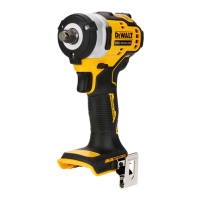10
ENGLISH
To Install the Battery Pack into the Tool
Handle
1. Align the battery pack
1
with the rails inside the tool’s
handle (Fig. B).
2. Slide it into the handle until the battery pack is firmly
seated in the tool and ensure that you hear the lock snap
intoplace.
To Remove the Battery Pack from the
Tool
1. Press the release button
2
and firmly pull the battery
pack out of the toolhandle.
2. Insert battery pack into the charger as described in the
charger section of thismanual.
Fuel Gauge Battery Packs (Fig. B)
Some DeWALT battery packs include a fuel gauge which
consists of three green LED lights that indicate the level of
charge remaining in the batterypack.
To actuate the fuel gauge, press and hold the fuel gauge
button
11
. A combination of the three green LED lights will
illuminate designating the level of charge left. When the
level of charge in the battery is below the usable limit, the
fuel gauge will not illuminate and the battery will need to
berecharged.
NOTE: The fuel gauge is only an indication of the charge left
on the battery pack. It does not indicate tool functionality
and is subject to variation based on product components,
temperature and end‑userapplication.
Belt Hook (Fig.A)
WARNING: To reduce the risk of serious personal
injury, turn tool off and disconnect battery pack
before making any adjustments or removing/
installing attachments oraccessories.
WARNING: To reduce the risk of serious personal
injury, DO NOT suspend tool overhead or suspend
objects from the belt hook. ONLY hang tool’s belt hook
from a workbelt.
WARNING: To reduce the risk of serious personal
injury, ensure the screw holding the belt hook
issecure.
CAUTION: To reduce the risk of personal injury or
damage, DO NOT use the belt hook to hang the
drill while using as aspotlight.
IMPORTANT: When attaching or replacing the belt hook,
use only the screw
9
that is provided. Be sure to securely
tighten thescrew.
The belt hook
8
can be be attached to either side of the tool
using only the screw
9
provided, to accommodate left‑ or
right‑ handed users. If the hook is not desired at all, it can be
removed from thetool.
To move belt hook, remove the screw
9
that holds it in
place then reassemble on the opposite side. Be sure to
securely tighten thescrew.
Variable Speed Trigger and Forward/
Reverse Control Button (Fig.C)
The tool is turned on and off by pulling and releasing the
variable speed trigger
3
. The farther the trigger is depressed,
the higher the speed of the tool. Your tool is equipped with
a brake. The chuck will stop as soon as the trigger switch is
fullyreleased.
A forward/reverse control button
4
determines the
rotational direction of the tool and also serves as a
lock‑offbutton.
• To select forward rotation (clockwise), release the trigger
and depress the forward/reverse control button on the
right side of thetool.
• To select reverse (counterclockwise), depress the
forward/reverse control button on the left side of
thetool.
NOTE: The center position of the control button locks the
tool in the off position. When changing the position of the
control button, be sure the trigger isreleased.
NOTE: Continuous use in variable speed range is not
recommended. It may damage the switch and should
beavoided.
NOTE: The first time the tool is run after changing the
direction of rotation, you may hear a click on start up. This is
normal and does not indicate aproblem.
Worklight (Fig.A)
The worklight
7
is activated when the trigger switch is
depressed, and will automatically turn off 20seconds after
the trigger switch is released. If the trigger switch remains
depressed, the worklight will remainon.
NOTE: The worklight is for lighting the immediate work
surface and is not intended to be used as aflashlight.
Anvil (Fig.A,D)
WARNING: Use only impact accessories. Non‑impact
accessories may break and cause a hazardous
condition. Inspect accessory prior to use to ensure that
it contains nocracks.
CAUTION: Inspect anvils, detent pins, and hog rings
prior to use. Missing or damaged items should be
replaced beforeuse.
Place the switch in the locked off (centre) position or remove
battery pack before changingaccessories.
To install an accessory on the hog ring anvil, firmly push
accessory onto the anvil
5
. The hog ring compresses
to allow the accessory to slide on. After accessory is
installed, the hog ring applies pressure to help provide
accessoryretention.
To remove an accessory, grasp the accessory and firmly pull
itoff.
OPERATION
Instructions for Use
WARNING: Always observe the safety instructions and
applicableregulations.

